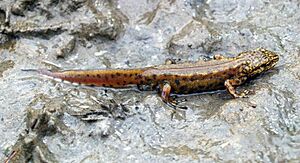Carpathian newt facts for kids
Quick facts for kids Carpathian newt |
|
|---|---|
 |
|
| Conservation status | |
| Scientific classification | |
| Genus: |
Lissotriton
|
| Species: |
montandoni
|
 |
|
| Synonyms | |
|
|
The Carpathian newt (Lissotriton montandoni), also known as Montandon’s newt, is a type of salamander. It belongs to the family Salamandridae. You can find this newt in countries like the Czech Republic, Poland, Romania, Slovakia, and Ukraine.
Adult Carpathian newts are usually about 10 centimeters (4 inches) long. They live in many different places. These include temperate forests, rivers, and ponds. They also live in marshes, farmlands, gardens, and pastures. Sadly, their homes are shrinking due to habitat loss.
Contents
What Does the Carpathian Newt Look Like?
The Carpathian newt can grow to about 10 centimeters (4 inches) long. Female newts are generally a bit bigger than males. Their skin feels bumpy when they are on land. However, it becomes smoother when they spend more time in water.
They have three special grooves on their head. Their body shape is quite square when you look at it from the side. The top part of their body is usually yellowish-brown or olive-brown. It often has many small, dark spots. Their belly is yellow or orange. It might have small black spots on the sides. The bottom part of their tail is white or orange with larger black spots.
During the breeding season, male newts look a bit different. They grow a small crest on their tail. They also have a tiny filament, like a thread, at the tip of their tail. They only have a slightly raised ridge along their back, not a big crest like some other newts.
Where Do Carpathian Newts Live?
The Carpathian newt lives in the eastern Carpathian Mountains. It also lives in the eastern Sudetes Mountains. You can find them at high places, up to about 2,000 meters (6,560 feet) above sea level. Some of these newts have also been brought to the Bavarian Forest in Germany.
Sometimes, the Carpathian newt lives in the same areas as the smooth newt. When this happens, they can sometimes have babies together. These babies look like a mix of both species. Carpathian newts prefer wet, shady woodlands. This includes both forests with pine trees and forests with broadleaf trees. They also like open areas in forests, forest edges, and upland pastures. They can even live in places where their habitat has changed a bit. They breed in both permanent and temporary water bodies.
How Do Carpathian Newts Behave?
Carpathian newts often stay close to the places where they lay their eggs. They like to hide under fallen trees, rocks, and loose bark. They start breeding in the spring. A female newt can lay up to 250 eggs in a year.
They choose different places to lay their eggs. These include ponds, pools, ditches, and even water-filled wheel ruts. They also use marshes and the edges of lakes. They prefer dark, cold, and slightly acidic water. But sometimes, they will use water that is a bit polluted. The eggs hatch in one to four weeks, depending on how warm it is. The young newts, called tadpoles, can change into their adult form in about twelve weeks. However, in colder, higher places, the tadpoles might stay in the water over winter. They become old enough to breed when they are about three years old.
What is the Carpathian Newt's Status?
The total number of Carpathian newts is probably going down. However, the International Union for Conservation of Nature (IUCN) says it is a species of "least concern". This means they are not in immediate danger of disappearing. This is because they live in a wide area. Also, there are still many of them, and they can handle some changes to their homes.


